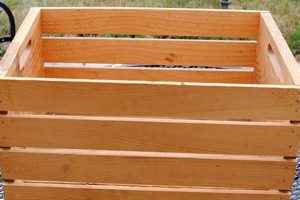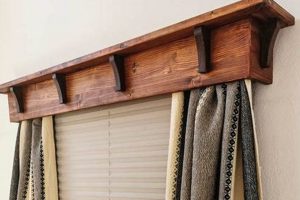A decorative framework, typically constructed from lumber, designed to conceal curtain hardware at the top of a window. This element enhances the aesthetic appeal of a room by providing a finished look and hiding rods or other mounting mechanisms. An example includes a simple rectangular box made from pine boards, stained to match existing trim and installed above a window to conceal a roller shade.
These structures offer an opportunity to personalize interior design at a lower cost compared to custom-made alternatives. Historically, window treatments were primarily functional, but the addition of decorative elements evolved to reflect changing styles and tastes. These wood components serve both a visual and practical purpose, adding architectural interest while managing light and privacy.
The following sections will provide a detailed exploration of design considerations, material selection, construction techniques, and installation guidelines for creating these window enhancements. Emphasis will be placed on achieving a professional-looking result through careful planning and execution.
Essential Considerations for Constructing a Wood Window Treatment
Achieving a high-quality result in crafting a custom window adornment requires careful attention to detail and adherence to sound construction practices. The following guidelines are presented to assist in this endeavor.
Tip 1: Accurate Measurement is Paramount: Precisely measure the width of the window opening, including any trim, before commencing construction. Inaccurate measurements will result in a valance that is either too small or too large, compromising its aesthetic appeal and functionality.
Tip 2: Select Appropriate Lumber: The choice of wood species influences both the appearance and structural integrity of the finished product. Pine is a cost-effective option, while hardwoods such as oak or maple offer greater durability and visual richness. Consider the existing decor and choose accordingly.
Tip 3: Prioritize Precise Cuts: Employ accurate cutting techniques, such as using a miter saw, to ensure that all pieces fit together seamlessly. Precise angles and square cuts are essential for achieving a professional appearance.
Tip 4: Implement Robust Joinery: Securely join the individual components using appropriate fasteners, such as screws or nails, and wood glue. Strong joints are crucial for preventing the valance from separating over time.
Tip 5: Smooth Surfaces are Essential: Thoroughly sand all surfaces to eliminate any imperfections or splinters. Smooth surfaces are necessary for achieving a flawless finish, whether painting or staining.
Tip 6: Select a Complementary Finish: Choose a paint or stain that complements the existing decor and provides adequate protection for the wood. Apply multiple thin coats, allowing each coat to dry completely before applying the next.
Tip 7: Secure Mounting Hardware is Critical: Use appropriate mounting hardware, such as screws and anchors, to securely attach the valance to the wall. Ensure that the hardware is strong enough to support the weight of the valance and any associated window treatments.
These considerations represent critical steps in producing a visually appealing and structurally sound window treatment. By following these guidelines, a homeowner can enhance the ambiance of a room with a unique and personalized touch.
The subsequent sections will address specific design styles and advanced construction techniques to further elevate the final product.
1. Accurate Measurement
The successful creation of a lumber window adornment is fundamentally contingent upon precise dimensional accuracy. An incorrect measurement at the outset cascades through the entire construction process, resulting in a final product that fails to meet functional or aesthetic requirements. Undersized components leave unsightly gaps, compromising the intended clean lines, while oversized pieces necessitate costly and time-consuming corrections or complete reconstruction. For example, if the initial width is measured one inch short, the entire frame will require adjustment, potentially affecting corner miters and overall visual balance. The resultant deviation from the planned design diminishes the desired level of professionalism and craftsmanship.
The necessity of accuracy extends beyond the overall width to encompass the depth and height. Insufficient depth may hinder proper concealment of window hardware, negating the primary function of the structure. Inadequate height affects the proportions and visual impact of the treatment within the room. Consider a scenario where the depth is underestimated; the curtain rod would be partially visible, detracting from the intended sleek appearance. Similarly, the precision of mitered corners relies on accurate angle calculations based on correct measurements; even a minor discrepancy in angle calculation results in gaps at the joints, diminishing structural integrity and aesthetic appeal. The cost of lumber, fasteners, and finishing materials is directly impacted by errors, making accurate measurement a critical element of project management, thereby reducing waste and optimizing resource allocation.
In conclusion, meticulous measurement serves as the bedrock for successful lumber window treatment projects. This foundational step minimizes material waste, reduces the potential for costly rework, and ensures the final product aligns with the intended design specifications. While seemingly straightforward, the impact of accurate measurement on project efficiency, cost-effectiveness, and aesthetic quality cannot be overstated, reinforcing its status as a primary determinant of success. Attention to detail in this initial phase will deliver significant benefits throughout the subsequent construction stages.
2. Material Selection
The selection of appropriate materials constitutes a critical decision point in the creation of a lumber window adornment. Material properties directly influence structural integrity, aesthetic appeal, and overall longevity of the finished product. Therefore, careful consideration should be given to the selection process.
- Wood Species and Structural Integrity
The choice of wood species directly impacts the structural performance of the frame. Softwoods, such as pine, offer ease of workability and lower cost, but may exhibit less resistance to denting and warping compared to hardwoods. Hardwoods, including oak and maple, provide greater dimensional stability and impact resistance, but often necessitate specialized tools and techniques for cutting and shaping. The intended dimensions and weight of the window covering should inform the species selection to ensure adequate support and prevent structural failure over time. For example, a large, heavy valance would benefit from the enhanced strength of a hardwood frame.
- Grain Pattern and Aesthetic Considerations
The grain pattern of the lumber significantly affects the visual appearance of the completed window enhancement. Straight-grained woods, such as poplar, provide a uniform surface that accepts paint readily and minimizes grain visibility. Species with prominent grain patterns, such as oak or cherry, add visual interest and texture. The chosen grain pattern should complement the existing decor and desired design style. A rustic interior may benefit from the character of a heavily grained wood, whereas a modern aesthetic may call for the clean lines of a straight-grained selection.
- Material Cost and Budget Constraints
The cost of lumber varies significantly based on species, grade, and availability. Exotic hardwoods command premium prices, while common softwoods offer cost-effective alternatives. Budgetary constraints often dictate material choices, necessitating a balance between desired aesthetic qualities and financial limitations. Consider utilizing locally sourced lumber or reclaimed wood to potentially reduce costs while contributing to sustainable practices. For instance, repurposing salvaged wood from deconstructed structures can provide unique character and reduce material expenses.
- Finishing Properties and Compatibility
The compatibility of the lumber with various finishing products is an essential consideration. Certain wood species accept stains and paints more readily than others. Open-grained woods, like oak, may require wood filler to achieve a smooth, even finish, while close-grained woods, such as maple, often yield a smoother surface with minimal preparation. The selection of finishing products should align with the properties of the chosen lumber to ensure proper adhesion, color penetration, and long-term durability of the finish. Failure to consider this aspect can result in uneven coloration, peeling, or other finish defects.
The facets of material selection extend beyond simple aesthetics and cost. A holistic assessment of structural requirements, visual preferences, budgetary limitations, and finishing properties ensures the creation of a visually appealing, structurally sound, and long-lasting lumber window adornment. Disregarding these factors can lead to premature failure, aesthetic dissatisfaction, and ultimately, increased long-term expenses. The initial investment in thoughtful material selection yields dividends in the form of enhanced durability, visual appeal, and overall value of the finished product.
3. Joint Construction
Joint construction forms a foundational element in the creation of any durable and aesthetically pleasing lumber window adornment. The method employed to join individual pieces of wood directly influences the structural integrity, longevity, and visual appeal of the finished valance. Inadequate joint construction can lead to premature failure, misalignment, and a compromised aesthetic.
- Miter Joints and Aesthetic Precision
Miter joints, characterized by angled cuts meeting at a precise corner, offer a clean, professional appearance for window valances. Their accurate execution is critical for creating seamless corners and a visually appealing frame. For instance, a 45-degree miter joint is commonly used to form right-angle corners. Imperfect miter joints result in visible gaps, detracting from the overall aesthetic. Proper alignment and secure fastening, using methods like wood glue and brad nails, are essential for maintaining the integrity of mitered corners over time.
- Butt Joints and Structural Simplicity
Butt joints, where two pieces of wood are joined end-to-end or edge-to-edge, represent a simpler construction method. While offering ease of assembly, butt joints lack inherent strength and require reinforcement through fasteners and adhesives. In lumber window adornments, butt joints are often utilized for connecting internal support structures or creating box-like forms. For example, a valance frame might employ butt joints to connect the front face to the side panels. Reinforcement with screws or dowels is essential to prevent separation under stress.
- Dado Joints and Enhanced Stability
Dado joints, characterized by a channel cut into one piece of wood to receive another, provide increased surface area for gluing and mechanical fastening, resulting in a stronger and more stable connection. In window valance construction, dado joints can be used to join side panels to a top or bottom piece, creating a rigid box structure. For example, side panels might be slotted to accept the top and bottom boards of the valance, significantly enhancing its resistance to racking and distortion.
- Pocket Hole Joinery and Concealed Fastening
Pocket hole joinery involves drilling angled holes into one piece of wood to allow for screw attachment to another. This technique offers a concealed fastening method, eliminating visible screw heads on the finished surface. In lumber window adornments, pocket hole joinery is particularly useful for attaching face frames or decorative elements. The screws are hidden within the pocket, resulting in a clean, professional appearance. Proper pocket hole placement and screw selection are essential for maximizing the strength and stability of the joint.
The selection of an appropriate joint construction technique is dictated by a combination of factors, including the desired aesthetic, the structural requirements of the lumber window adornment, and the skill level of the builder. Miter joints offer a refined appearance, while butt joints provide simplicity. Dado joints enhance stability, and pocket hole joinery conceals fasteners. Careful consideration of these factors leads to a durable, visually appealing, and long-lasting valance that effectively complements the window and the surrounding decor.
4. Surface Finishing
Surface finishing is inextricably linked to the successful fabrication of a lumber window adornment. It represents the culmination of the construction process, directly impacting the visual appeal, durability, and protective qualities of the finished product. Proper surface finishing transforms a basic wooden structure into a polished element, enhancing the overall aesthetic of the room. Failure to adequately address surface preparation and finishing can result in an unprofessional appearance, diminished longevity, and increased susceptibility to environmental damage. For example, a poorly sanded valance will exhibit uneven paint absorption, resulting in a blotchy and unattractive finish. Similarly, omitting a protective topcoat can leave the wood vulnerable to moisture damage and scratches.
The specific techniques employed in surface finishing are contingent upon the desired aesthetic and the properties of the chosen lumber. Sanding, priming, painting, staining, and applying protective topcoats are common steps in the finishing process. Sanding removes imperfections, creates a smooth surface for subsequent treatments, and promotes optimal adhesion. Priming seals the wood, prevents excessive paint absorption, and provides a uniform base for the final color. Painting offers a wide range of color options and provides a durable, opaque finish. Staining enhances the natural grain patterns of the wood, adding warmth and depth. Protective topcoats, such as varnish or polyurethane, shield the surface from moisture, scratches, and UV radiation. Choosing compatible finishing products and employing appropriate application techniques are critical for achieving professional-quality results. An instance would be applying a gel stain to a softwood valance, highlighting the grain without overly penetrating the material, followed by a satin polyurethane for moisture resistance and a subtle sheen.
In summary, surface finishing is not merely a cosmetic addition but an integral component of creating a quality lumber window adornment. The meticulous application of appropriate techniques and materials provides protection, enhances visual appeal, and contributes to the longevity of the valance. Neglecting the nuances of surface finishing undermines the craftsmanship invested in earlier stages, ultimately diminishing the value and impact of the finished product. By prioritizing proper surface preparation and finishing, one ensures the window enhancement serves as both a functional and visually pleasing element within the interior space.
5. Mounting Security
The secure attachment of a window adornment constructed from lumber is paramount to its overall functionality and safety. Insufficient mounting practices can lead to structural instability, potential damage to surrounding architecture, and even personal injury. Mounting security directly impacts the long-term viability and aesthetic presentation of the installation. Failure to adequately secure the valance undermines the investment of time, resources, and effort expended in its construction.
The method of attachment must account for several factors, including the weight of the lumber construction, the composition of the wall, and the intended use of any associated window treatments. For example, a heavy oak valance requires more robust anchoring systems compared to a lightweight pine structure. Furthermore, drywall construction necessitates the use of anchors capable of distributing the load, preventing pull-through and subsequent detachment. Practical application includes scenarios where a valance is installed above a frequently used window covering, such as a heavy blackout curtain. The added stress exerted on the valance during daily operation demands a secure mounting strategy, incorporating appropriately sized screws and anchors to withstand the cumulative force.
In summation, robust mounting security is an indispensable element of a successful lumber window adornment project. Selecting the appropriate hardware, employing correct installation techniques, and carefully considering the weight and load-bearing capacity are critical steps. Overlooking these considerations jeopardizes the structural integrity of the installation, potentially leading to costly repairs or hazardous conditions. Therefore, prioritizing secure mounting practices is not merely a precautionary measure, but a fundamental requirement for ensuring the safety, longevity, and aesthetic integrity of the completed project.
Frequently Asked Questions
The following addresses common inquiries regarding the creation of window valances from lumber, providing guidance to ensure a successful outcome.
Question 1: What is the recommended lumber for a basic valance project?
Pine is a suitable choice for beginner projects due to its workability and cost-effectiveness. More experienced individuals might consider hardwoods such as poplar or maple for increased durability and a finer finish.
Question 2: What tools are essential for constructing a wood window valance?
A miter saw, drill, sander, measuring tape, and level are fundamental. Additional tools, such as a pocket hole jig or router, enhance construction possibilities but are not strictly required.
Question 3: How does one accurately measure for a valance?
Measure the width of the window, including any trim. Add a predetermined amount to each side for overhang, typically between two and six inches, depending on aesthetic preference.
Question 4: What is the best method for joining wood pieces?
Miter joints offer a clean appearance for corners. Butt joints are simpler but require reinforcement. Pocket hole joinery provides a concealed fastening option. The method should align with the design and skill level.
Question 5: What type of finish is appropriate for a wood window valance?
Paint offers a wide range of colors, while stain enhances the natural grain. Apply a primer before painting to improve adhesion. A protective topcoat, such as polyurethane, safeguards against moisture and scratches.
Question 6: How does one securely mount a wood window valance?
Use appropriate mounting hardware, such as screws and wall anchors, selected based on the valance weight and wall construction. Ensure the hardware is adequately rated to support the load.
These answers provide a foundation for understanding the key aspects of window valance construction. Careful planning and execution are crucial for achieving a professional result.
The subsequent section will explore advanced design techniques and customization options to further enhance the window valance.
diy wood window valance
This exploration has illuminated the multifaceted considerations inherent in crafting a diy wood window valance. From meticulous measurement and judicious material selection to robust joint construction, precise surface finishing, and secure mounting practices, each stage demands careful attention to detail. A neglect of any of these elements compromises the final product’s aesthetic appeal, structural integrity, and long-term durability.
The enduring appeal of a diy wood window valance lies in its capacity to personalize interior spaces while offering a cost-effective alternative to bespoke treatments. The commitment to quality workmanship and adherence to established principles ensures the creation of a window enhancement that serves as both a functional and visually compelling addition to the home. Further investment in knowledge and technique will undoubtedly elevate the craft, transforming a simple project into a testament to skilled artistry.







